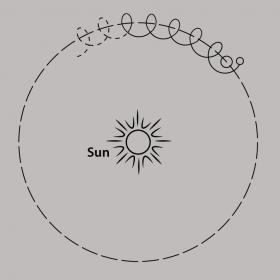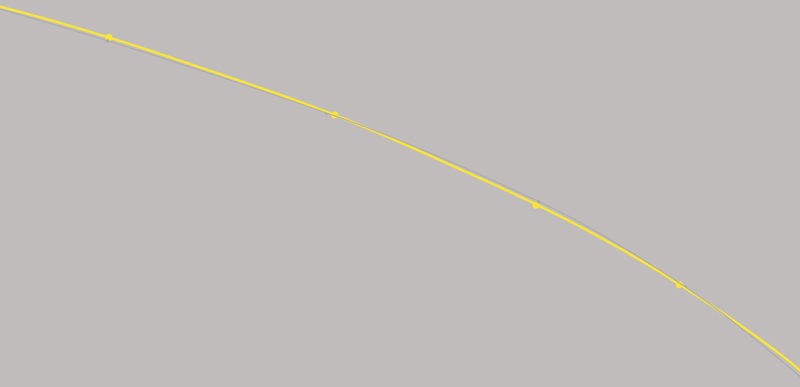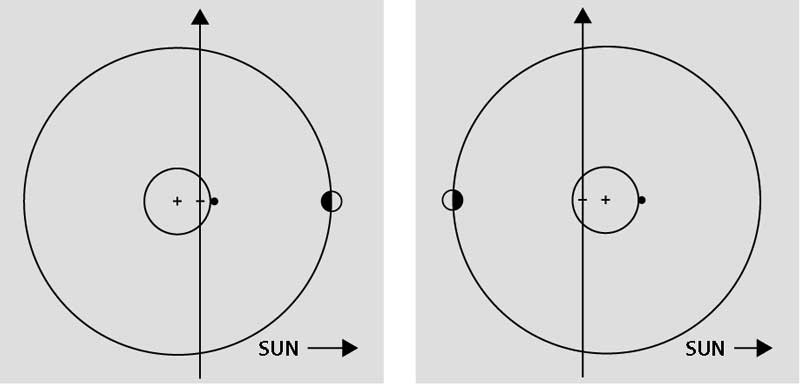Loopy Physics: The Answers
Fall
2016
Physics Puzzler
Loopy Physics: The Answers
Celestial Textbook Misconceptions
By:Donald Simanek, Emeritus Professor of Physics, Lock Haven University of Pennsylvania
Answers
 01 The Moon orbits Earth once every 29.53 days with respect to the Sun (which is called the synodic period). So it makes only about 12.4 orbits in a year. Figure 1 suggests many more orbits than that.
01 The Moon orbits Earth once every 29.53 days with respect to the Sun (which is called the synodic period). So it makes only about 12.4 orbits in a year. Figure 1 suggests many more orbits than that.
Figure 1 is clearly not to scale. The loops are much too large for the Moon's orbit around the Earth. But does the Moon actually make such a loopy path, crossing itself every month?
In fact, the Moon's path never crosses itself, so the description of its path as a "rosette" is clearly misleading. The true path, to scale, looks like this:

Textbooks and popular science publications ought to more liberally use the picture caption disclaimer "Not to scale." But scale isn't the only problem here.
The striking thing about the Moon’s true path around the Sun is that it is nearly circular, never crosses itself, and is always concave toward the Sun. Earth and the Moon both orbit the Sun in nearly the same path as they swing around their common center of mass, like a pair of gracefully whirling ice dancers. The center of mass of the Earth-Moon system (the barycenter) is within the body of the Earth, at a distance of 4,671 km away from Earth's center. Remember that Earth's radius is 6,378 km. The barycenter makes an elliptical—but still near-circular—orbit around the Sun. The Earth and Moon both orbit the barycenter. Neither path is loopy. They are both near circular.
This book got one thing right. It says "...both the Earth and the moon are in nearly circular orbits about the sun." Unfortunately, the authors went astray in the rest of their explanation, and the artist who drew the picture didn't get the correct message.
02 The barycenter is again important here. The Earth is closer to the Sun at full moon. At noon at full moon, the center of the Earth is 2 × 4,671 = 9,342 km closer to the Sun than it is at noon at new moon. So you are also that much closer to the Sun at noon at the time of new moon.

The Earth's axis is tilted with respect to the Earth's orbital plane, and the Moon's orbital plane is also tilted (and also eccentric), so your distance from the Sun depends on where on the Earth you are standing and the Moon's position in its orbit at that time. We didn't ask for a quantitative answer. You are welcome to puzzle that out. Nor will we speculate how much sooner you would get a tan lying on the beach at noon when the Moon is full. //
Feedback is appreciated from readers. E-mail dsimanek [at] lhup.edu. If you have a favorite physics puzzle that is not well known, not easily found on the web, or in the many published physics problem books, send it along. Include your answer, too, if you have one. If used, we'll credit you. I especially like puzzles that can be solved with insightful and simple arguments, preferably with minimal mathematics. As this puzzle illustrates, textbook misconceptions often make good puzzles.
